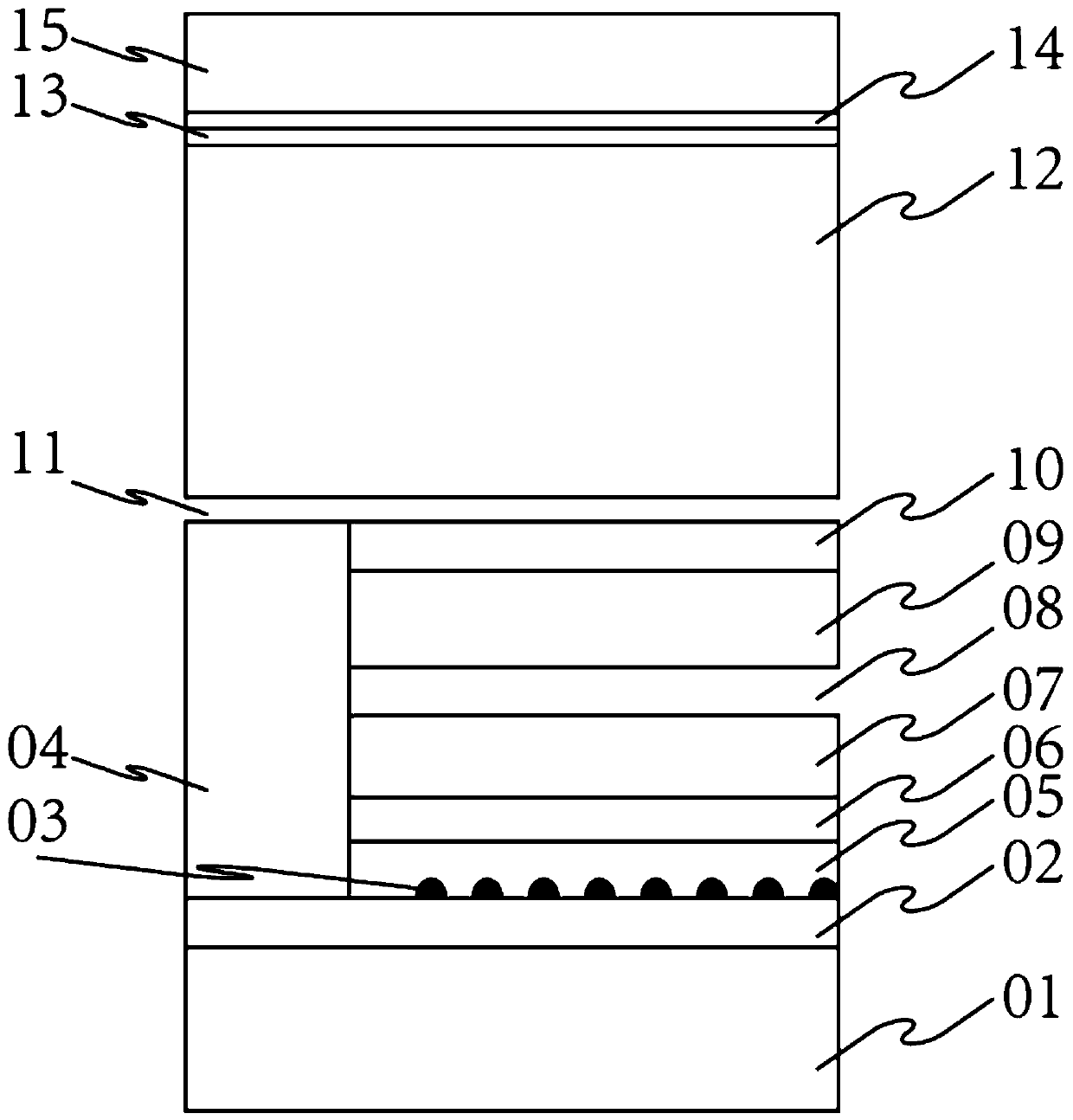High-speed working temperature DFB laser and manufacturing method thereof
A technology of DFB lasers and lasers, which is applied in the direction of lasers, semiconductor lasers, phonon exciters, etc., can solve the problems of DFB laser high-temperature modulation rate reduction, etc., and achieve fast modulation rate, improved reliability, and good high-temperature characteristics.
- Summary
- Abstract
- Description
- Claims
- Application Information
AI Technical Summary
Problems solved by technology
Method used
Image
Examples
preparation example Construction
[0031] A preparation method for a high-speed DFB laser, comprising the steps of:
[0032] Step 1: Using InP as the growth substrate, the buffer layer 02 and the grating layer are sequentially grown on the InP substrate 01 to obtain the first epitaxial structure, such as figure 2 Then take out the epitaxial wafer, spin-coat photoresist, use holographic lithography or electron beam lithography to form a grating pattern, and then use optical lithography to define the first waveguide region, and use chemical wet etching method to form a partial raster; as in image 3 shown.
[0033] Step 2: Carry out the second epitaxial growth on the basis of step 1; first, in the pH 3 Under the protection of gas, slowly raise the temperature to 550°C, and then feed TMIn in pulses as the source gas to grow InP. When the thickness of the InP layer 050 completely covers the grating, raise the temperature to the normal epitaxial growth temperature of 670°C, increase the flow rate of TMIn, from R...
Embodiment 1
[0043] With a conductivity of 2-8x10 18 cm -2 The InP is used as the growth substrate and put into the MOCVD system of Aixtron Company for growth. The reaction chamber pressure was 50mbar, the growth temperature was 670°C, and the 2 As carrier gas, trimethylindium (TMIn), trimethylgallium (TMGa), trimethylaluminum (TMAl), diethylzinc (DeZn), silane (SiH 4 ), arsine (AsH 3 ) and phosphine (PH 3 ) and the like are reaction source gases, and sequentially grow an N-InP buffer layer, an N-InGaAsP grating layer, and an N-InP transition layer. Among them, the thickness of the grating layer is 50nm. It is worth noting that the grating layer N-InGaAsP is a tensile strain, and the strain is 500-1000ppm.
[0044] Then the grown epitaxial wafer is taken out, and a grating is formed by holographic lithography or electron beam lithography. The grating period is 203nm and the depth is 70nm. At the same time, the wave layer region B is formed by optical lithography, and the width of the...
Embodiment 2
[0057] The epitaxial wafer preparation process is the same as that of Embodiment 1.
[0058] After the growth of the epitaxial wafer is completed, the ridge waveguide structure is formed by photolithography and etching process, and then the front electrode is evaporated on the ridge waveguide structure, and then part of the area is exposed by photolithography, and the diamond high thermal conductivity layer is formed by PECVD. The thermal conductivity of diamond is greater than 20W / (m·K), and it is the semiconductor material with the highest thermal conductivity known so far, and it has high hardness and stable chemical properties. It is worth noting that the diamond material cannot cover the ridge to avoid damage to the ridge caused by inconsistent stress at high temperature. Then the InP substrate is thinned, and the back electrode is evaporated on the back of the thinned InP substrate; a high reflective film (90% reflectivity) is evaporated on one end of the tube core, and ...
PUM
 Login to View More
Login to View More Abstract
Description
Claims
Application Information
 Login to View More
Login to View More - R&D
- Intellectual Property
- Life Sciences
- Materials
- Tech Scout
- Unparalleled Data Quality
- Higher Quality Content
- 60% Fewer Hallucinations
Browse by: Latest US Patents, China's latest patents, Technical Efficacy Thesaurus, Application Domain, Technology Topic, Popular Technical Reports.
© 2025 PatSnap. All rights reserved.Legal|Privacy policy|Modern Slavery Act Transparency Statement|Sitemap|About US| Contact US: help@patsnap.com



